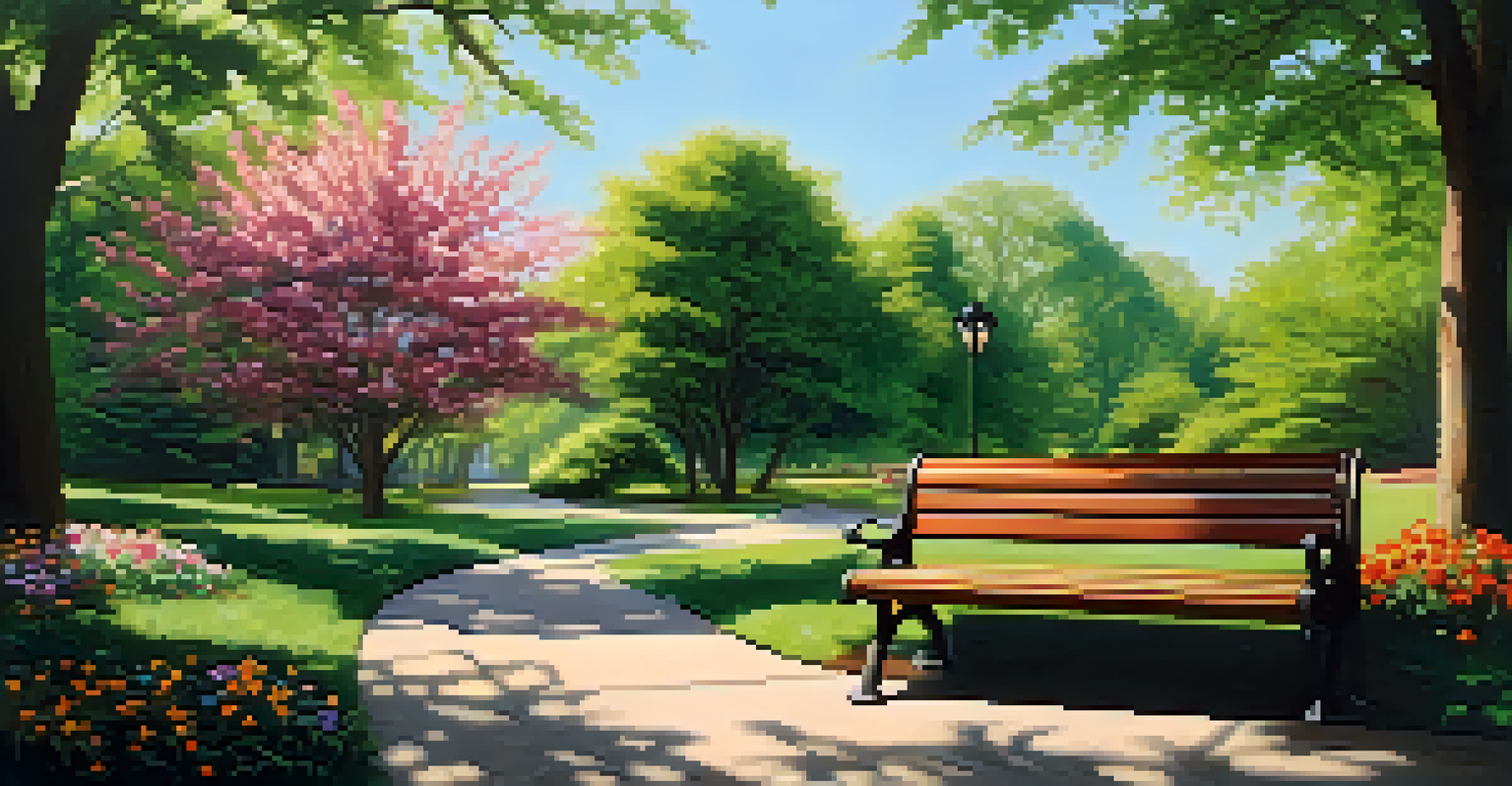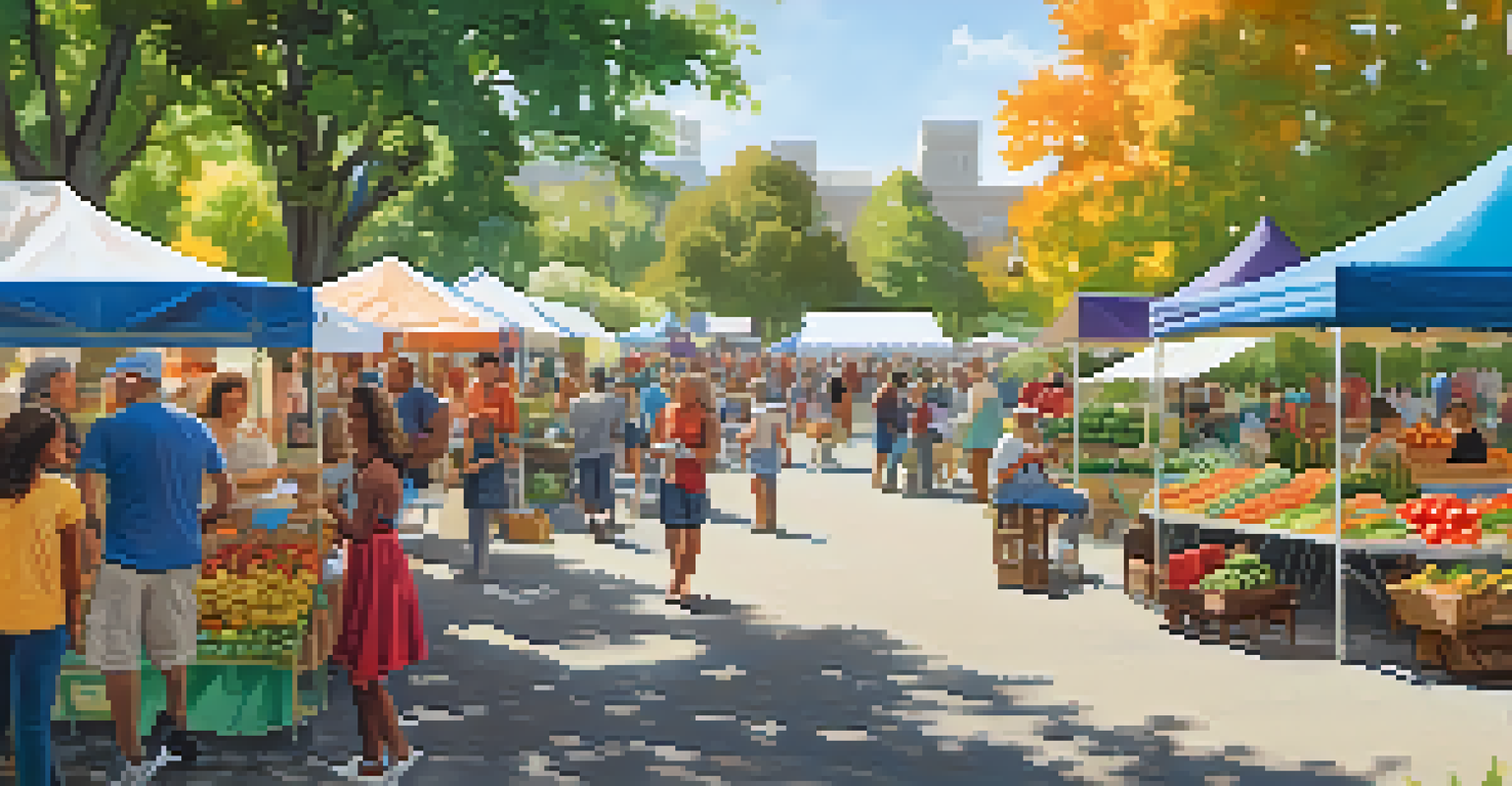Benefits of Community Parks for Local Neighborhoods

Community Parks: A Vital Resource for Neighborhoods
Community parks serve as essential spaces for local residents, offering a place to relax, play, and socialize. These parks often feature playgrounds, walking trails, and picnic areas, making them perfect for family outings or casual strolls. By providing accessible green spaces, community parks encourage a sense of belonging and connection among neighbors.
Parks are not just green spaces; they are places where communities thrive and connections are made.
Moreover, parks can act as a hub for community events, such as farmers' markets, festivals, or outdoor movie nights. Such gatherings not only bring people together but also foster a sense of pride in the community. When residents participate in these activities, they build relationships that can lead to lasting friendships.
In essence, community parks play a crucial role in enhancing the quality of life in neighborhoods. They offer an inviting environment where residents can create memories and strengthen social ties, making the community a more vibrant place to live.
Promoting Physical Health Through Outdoor Activity
One of the most significant benefits of community parks is their ability to promote physical health. With walking paths, sports fields, and fitness stations, parks encourage residents to engage in outdoor activities. Regular physical exercise is vital for maintaining a healthy lifestyle and can significantly reduce the risk of chronic diseases.

Additionally, parks provide a safe space for children to play and explore, which is essential for their physical development. Whether it's running around on the grass or climbing on playground equipment, these activities help children build strength and coordination. Parents can have peace of mind knowing their kids are active and having fun in a secure environment.
Parks Enhance Community Connections
Community parks foster social ties and a sense of belonging among residents through shared activities and events.
Furthermore, the availability of green spaces has been linked to improved mental health. When people spend time outdoors and engage in physical activity, they often experience reduced stress and anxiety levels, contributing to overall well-being.
Enhancing Mental Well-Being with Nature
Community parks are not just about physical health; they also significantly contribute to mental well-being. Spending time in nature has been shown to reduce symptoms of depression and anxiety. The calming effect of green spaces can provide a much-needed escape from the hustle and bustle of daily life.
The creation of parks is a fundamental investment in the health and well-being of a community.
Imagine sitting on a park bench, surrounded by trees and the sound of birds chirping. This serene environment allows individuals to relax, reflect, and recharge. Many people find that a simple walk in the park can lift their spirits and improve their mood.
Moreover, parks can serve as spaces for mindfulness practices, such as yoga or meditation. Engaging in these activities in a tranquil setting can enhance their effectiveness, offering a holistic approach to mental health.
Fostering Community Engagement and Volunteerism
Community parks often become focal points for civic engagement, encouraging residents to get involved in their neighborhoods. This involvement can take many forms, from organizing clean-up events to participating in park advisory committees. When people take an active role in maintaining their local parks, they develop a sense of ownership and responsibility.
Additionally, volunteering in parks can foster connections among residents. When neighbors come together for a common cause, they build relationships and strengthen community ties. These interactions can lead to increased trust and collaboration among residents, ultimately enhancing the neighborhood's overall sense of community.
Health Benefits of Outdoor Spaces
Parks promote physical and mental well-being by providing spaces for exercise, relaxation, and nature engagement.
By nurturing these connections, community parks can become catalysts for positive change, encouraging residents to work together on various initiatives that benefit the entire neighborhood.
Environmental Benefits of Community Parks
Community parks play a crucial role in promoting environmental sustainability. They provide habitats for wildlife, support biodiversity, and help to improve air quality. Trees and plants in parks absorb carbon dioxide and release oxygen, contributing to a healthier environment for everyone.
Moreover, parks can help combat urban heat by providing shaded areas and cooling the surrounding environment. This is especially important in densely populated areas where heat islands can significantly impact local climates. By incorporating green spaces, communities can mitigate these effects and enhance their overall livability.
Additionally, parks can serve as effective stormwater management systems. By allowing rainwater to soak into the ground, they reduce runoff and help prevent flooding. This natural approach to managing water can save communities money on infrastructure while promoting ecological health.
Increasing Property Values and Local Economy
The presence of community parks can enhance property values in the surrounding neighborhoods. Homes located near well-maintained parks often command higher prices, as many buyers see proximity to green spaces as a desirable feature. This increase in property values benefits not only homeowners but also the local economy.
Furthermore, parks can attract businesses and tourism to the area. Local shops, restaurants, and cafes benefit from increased foot traffic generated by park visitors. This boost in economic activity can lead to job creation and provide a more vibrant local economy.
Economic Growth Through Green Spaces
The presence of community parks can increase property values and attract businesses, boosting the local economy.
Ultimately, the investment in community parks can yield significant returns for neighborhoods, making them more attractive places to live, work, and play.
Strengthening Cultural Identity and Community Pride
Community parks often serve as venues for cultural events and celebrations, helping to strengthen the cultural identity of neighborhoods. From art fairs to music festivals, these gatherings highlight local talent and traditions, fostering a sense of pride among residents. When people celebrate their culture together, they create lasting memories that bind the community.
Moreover, parks can provide spaces for public art installations, showcasing the creativity of local artists. These artistic expressions can enrich the park's environment, making it more inviting and visually appealing. A park adorned with murals and sculptures can become a source of inspiration and joy for the entire community.

The collective experiences and shared celebrations that occur in community parks help to build a strong sense of belonging. By investing in parks, neighborhoods can cultivate a unique identity that reflects their values and aspirations.
The Future of Community Parks in Neighborhoods
As communities continue to grow and evolve, the role of community parks will remain vital. Future park designs may focus on sustainability, inclusivity, and technological integration. This could include the use of native plants, eco-friendly materials, and facilities that cater to diverse populations.
Moreover, engaging residents in the planning and development of parks can ensure that these spaces meet the needs of the community. By involving local voices, planners can create parks that reflect the desires and values of the neighborhood, fostering a sense of ownership and pride.
Looking ahead, the continued investment in community parks will be essential for enhancing the quality of life in neighborhoods. By prioritizing green spaces, communities can create vibrant, connected, and resilient environments for generations to come.